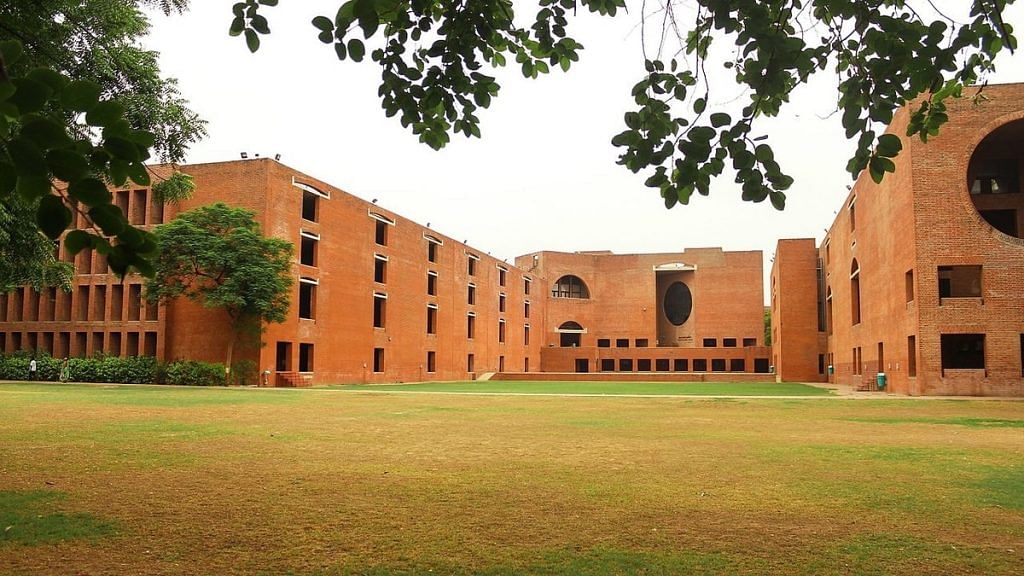New Delhi: A group of alumni from the Indian Institute of Management in Ahmedabad (IIM-A) have slammed the management’s decision to demolish 14 of its 18 dorm buildings that were conceptualised and built in 1974 by the legendary American architect Louis Kahn. Many of them believe the heritage buildings should instead be restored.
In a letter dated 23 December, Director Errol D’Souza had written to the alumni stating that the buildings were “unsafe for living”. The letter also noted that after the 2001 Bhuj earthquake, water seepage through ageing and deterioration of the exposed brick walls have resulted in “large cracks in the masonry and periodical detachments of it in fragments”.
The letter also stated that the remaining four dorm buildings will be restored, along with the library, teaching complex and the faculty wings. The premier institute had in 2014 restored two of its other damaged buildings, which included dorm 15 and the Vikram Sarabhai Library.
About 300 former students have created a WhatsApp group called ‘Save Louis Kahn’s IIMA’ to discuss the matter. There is also a separate group on Telegram. The alumni forum has around 45,000 members.
IIM-A alumnus Vishweshwar Raste, director of a Pune-based think tank called Center for Holistic Human Development and Research, told ThePrint, “All the buildings are a part of the campus’ body and demolition of any buildings will be like removing limbs from an organism’s body. The original creator of the campus had a design in his mind that he created in the form of this campus, you can not partially remove and reconstruct some of it, it will be ugly.”
Before the letter was sent to the alumni on 4 December, the institute had sent out a notice for tenders to rebuild the buildings. Many members of the alumni forum have now expressed displeasure over the management’s delay in communicating to them.
“If the tender was floated on 4 December, why was the alumni informed on 23 December? It is a very sad state of affairs,” said Raste.
Salem Ganapathy, a 1971 postgraduate student of the institute, also said, “We lived in the dorm about 50 years ago. Whenever I meet a recent pass out from the institute, I ask them their dorm room number. It is the love for our shared buildings which connects us all.”
“I understand that the number of courses have increased and they need more space to accommodate the increasing number of students. But what disappoints me is that the space was not maintained over the years. Brick buildings in other countries survive for about 100 years. Why is it that only in our country such a beautiful piece of modern architecture loses its integrity within 50 years?” Ganapathy added.
Also read: What JNU, BHU & AMU are doing to keep their students, campuses protected from Covid
‘Buildings can be restored’
Talking about the architectural aspect of the building, Shubhra Raje, a professor at CEPT University in Ahmedabad, and daughter of Anant Raje who was Kahn’s associate and overlooked the expansion of the IIM-A campus in the 1980s and 1990s, said, “The news of deconstruction came as a shock to us. The restoration of dorm 15 and the library are a proof of the fact that the buildings can be restored.”
Talking about the structural integrity of the buildings, she said, “Clay bricks used by Kahn have surprisingly not fared well. The 2001 earthquake proved to be a major factor in the deterioration of these bricks. But for this it is important to understand that the bricks from the clay of Ahmedabad don’t have the kind of density that clay from Sri Lanka or Bangladesh would have.”
Raje was referring to the director’s letter that said the bricks used by Kahn were of “second class” nature and “had an inbuilt efflorescence”.
“The agencies involved in restoration of the buildings have not only done a phenomenal job but have also looked into the materials used by Kahn and found improvements to aid the structures,” she added.
Brinda Somaya, one of the architects involved in the restoration of dorm 15 and the library, had, in one of her sessions explained about the integrity of the structure and how they went about restoring it.
When contacted, a spokesperson for IIM-A said the university has not made any further communication with the alumni regarding the demolition drive.
Also read: Govt asks states if they want to take part in post-Matric scholarship scheme for SC students
